Interview with artist Tom Richard
Tom Richard is an artist and educator originally from Houma, Louisiana. He earned a BFA from Louisiana State University in 1988 and an MFA from the University of Albany in 1993 and is currently a Professor of Art at the University of Arkansas at Monticello. Tom’s mixed media paintings are spontaneous reflections with historical and pop culture references and have been exhibited throughout the country. More of his work can be found at his website, tomrichardart.com.
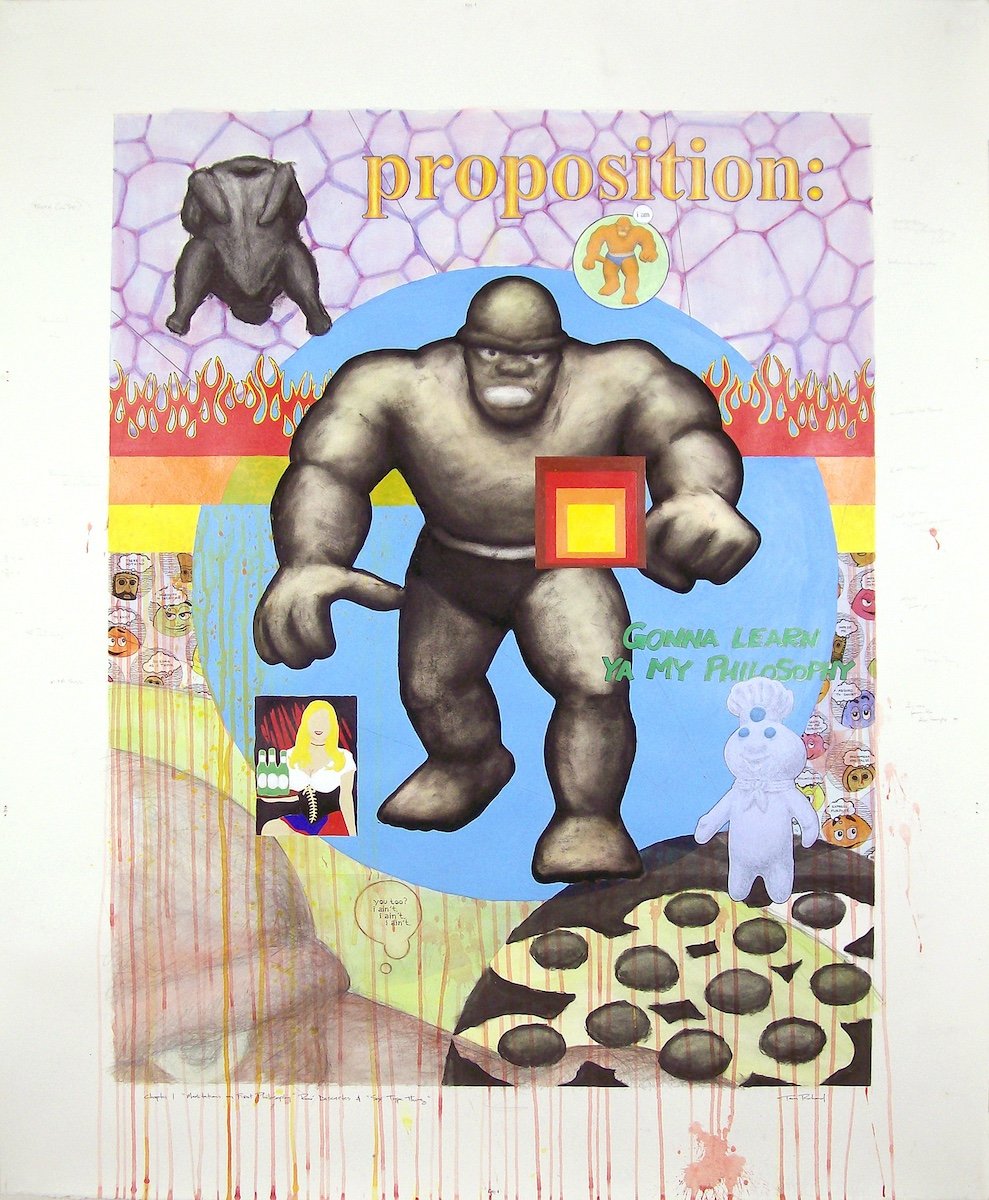

AAS: Tom, I understand you are a South Louisiana boy like I am. What brought you to Arkansas and the University of Arkansas Monticello?
TR: A path of “least” or “most” resistance (or some approximation between the two). HA! Yep, I’m a Cajun from South Louisiana. I loved being born and raised in Houma, but I knew from an early age that I wanted to leave. I moved to Arkansas in 1997 after living in upstate New York and then in central Missouri to rebuild the art program at the University of Arkansas Monticello. As a father, I wanted to raise my children in a similar environment that I grew up in. I realized that I wanted to be in a space that had a strong sense of community, had little to no traffic, and was a place where I could have a dedicated studio space in my backyard – that was not an attic, a carport, a garage, or the corner of our living room.
AAS: Was art or just being creative an important part of your life growing up?
TR: Yes. I was always “making”. My parents were creative. My mother was a homemaker, and a painter, and taught after-school art lessons. My father, a veterinarian, was a back-yard mechanic, a wood carver, and could fix anything. We would go to craft fairs, where my parents would sell their work, and where I would draw caricatures for $5/a pop and sell handmade tie tacks and pins.
As a young kid, I would wake up early on Saturday mornings to move the plastic “kids” furniture around to cover with quilts and make my fort with a viewing portal to watch, first the “town and country” farm report, then a B-movie in black and white like Cat-Women of the Moon, then Saturday morning cartoons. My early years of watching “Saturday-morning cartoons” and reading comic books and encyclopedias are a big influence on my work.
AAS: Tell me more about your art education and did you begin that journey knowing you eventually wanted to teach at the university level?
TR: No, as a 20-something-year-old my life plan did not involve being an educator. I did not originally pursue Art in higher education because I was told, “you can’t make money with an art degree”. I did not choose art as a major until I dropped out for a semester, right before failing out of my original major.
My professors at both LSU and SUNY – Albany (now named the University at Albany) were wonderful and really challenged their students to excel. Both programs were very competitive and as students we really pushed each other at both the graduate and undergraduate level.
I have had many jobs and forms of employment including blackberry picker, hog raiser, caricaturist, swimming instructor, ice cream scooper, back-yard mechanic, cartoonist, dish washer, cook, computer salesman, tie-tack maker, t-shirt designer, tug boat deckhand, darkroom photography worker, pool table installer, communicable disease specialist, inventory worker, book cover designer, and after school art instructor.
Life happens. And I realized I was good at stuff like teaching people how to draw a straight line, teaching students how to slow down and “see,” explaining and demonstrating techniques, and helping others to discover “their” answers. I didn’t just fall into teaching but realized that skills that I had gained through experiences could be passed on. Also, teaching has given me the freedom to pursue artistic directions that are not based upon the monetary decisions of “living” off of my creative pursuits.
“My early years of watching Saturday-morning cartoons and reading comic books and encyclopedias are a big influence on my work.”
AAS: Tom, I would like to begin with your most recent project, Bubble Gum on Janson’s History of Art. That exhibition was recently at the South Arkansas Arts Center. What was the genesis of that major project?
Bubble Gum on Janson’s History of Art Series, acrylic, watercolor, ink on book cover, framed: 15” x 12”
TR: Chewing gum was not allowed in school. In order to not get caught, I would stick my chewed gum under the tabletop of my desk. The undersides of desks were full of gum.
Bubble Gum on Janson’s History of Art Series (BGOJHoA) is a series of acrylic and watercolor paintings of illusionistic bubble gum on one image from every page of the 1966 edition of Janson’s History of Art. I did not redraw the images. The black and white images are the actual/real pages from the textbook.
The 287 paintings on textbook paper, grouped by chapters, are presented in the order that they existed in the original book. The paintings are individually framed, and each page is matted to mask the text from the page while presenting the image in the original page location and orientation – yes, some in their orientation in the original textbook are side-ways. The entire series was exhibited at the South Arkansas Art Center in El Dorado, AR in June of last year and Part 1 of the series was exhibited at Baton Rouge Gallery in early spring of 2023.
The painted bubble gum masks a prominent part of the composition, which could be the primary focal point, but in some cases, is the secondary or tertiary one, to hint at a transformation: from black & white to color, appropriation to original, high to low, masking to potential, and serious to whimsy. The idea of the frivolous amongst the sacred interests me.
This series addresses how we view history. And also, in a past history (almost 6 decades ago), how we viewed history. As Janson’s History of Art is the canonized Art Historical text, that through time has been reprinted to address changes in thought of how we view history, this series uses the 1966 edition (the year of my birth) to relate to how the past viewed the past. In the series I make fun of and play with that past.

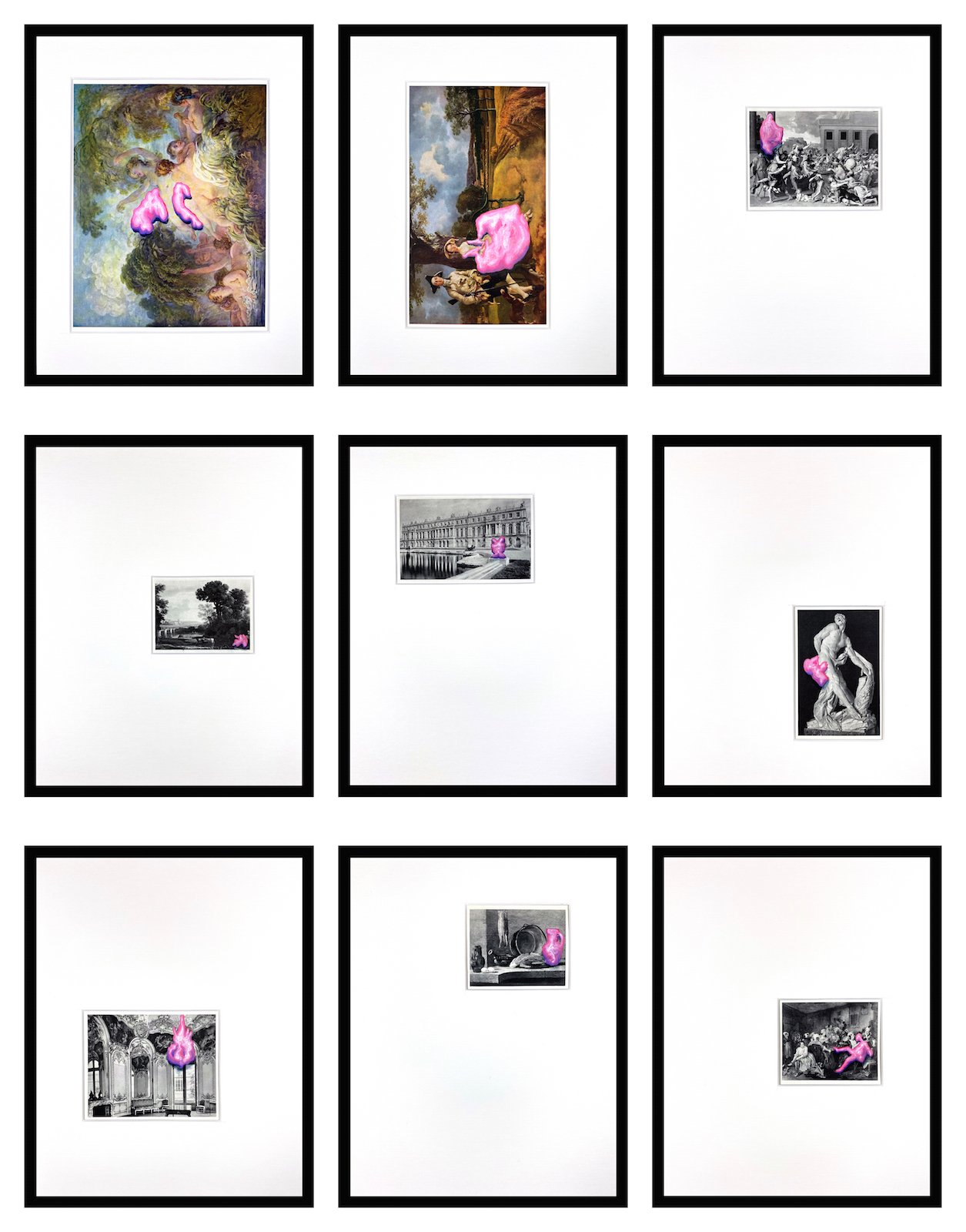
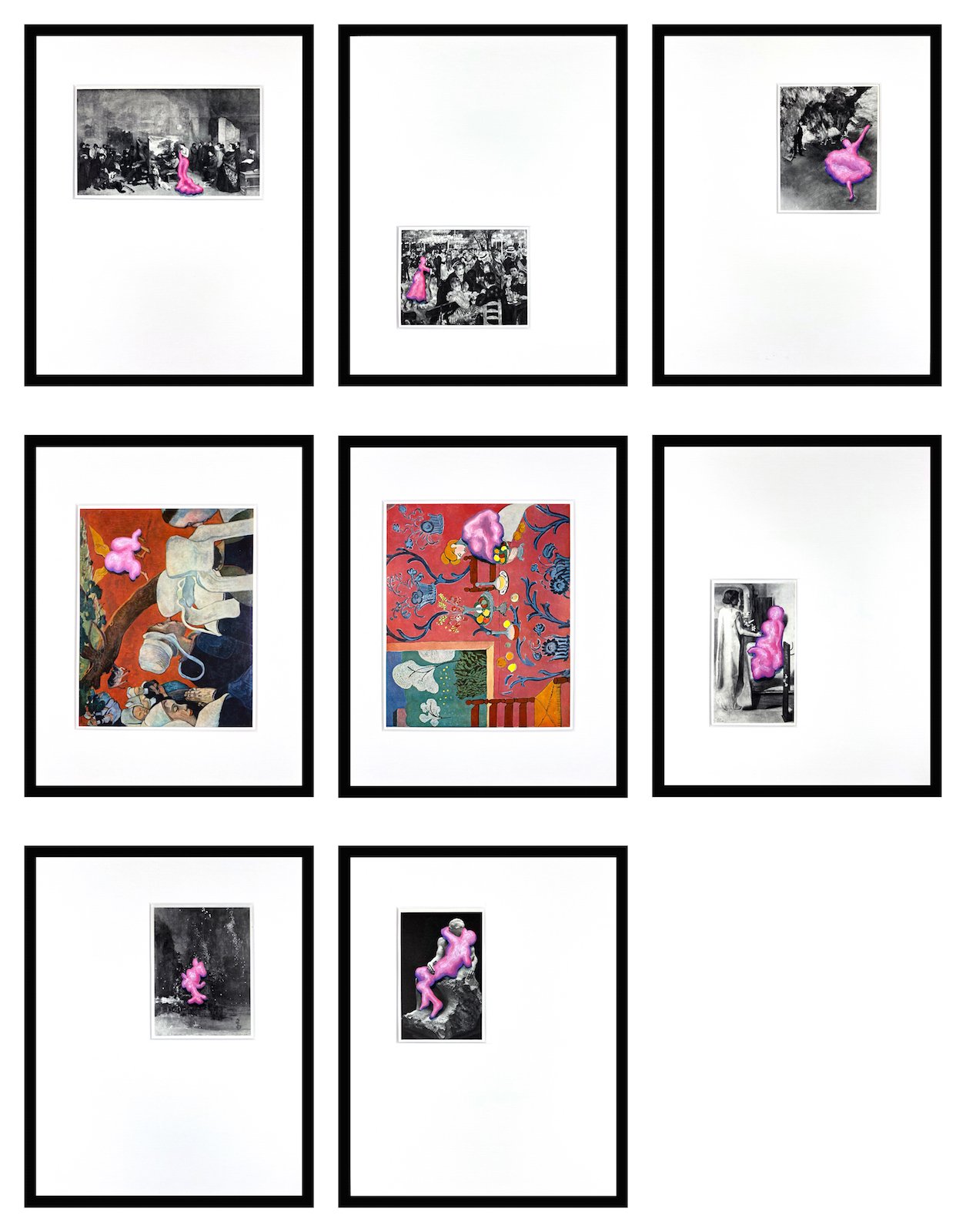
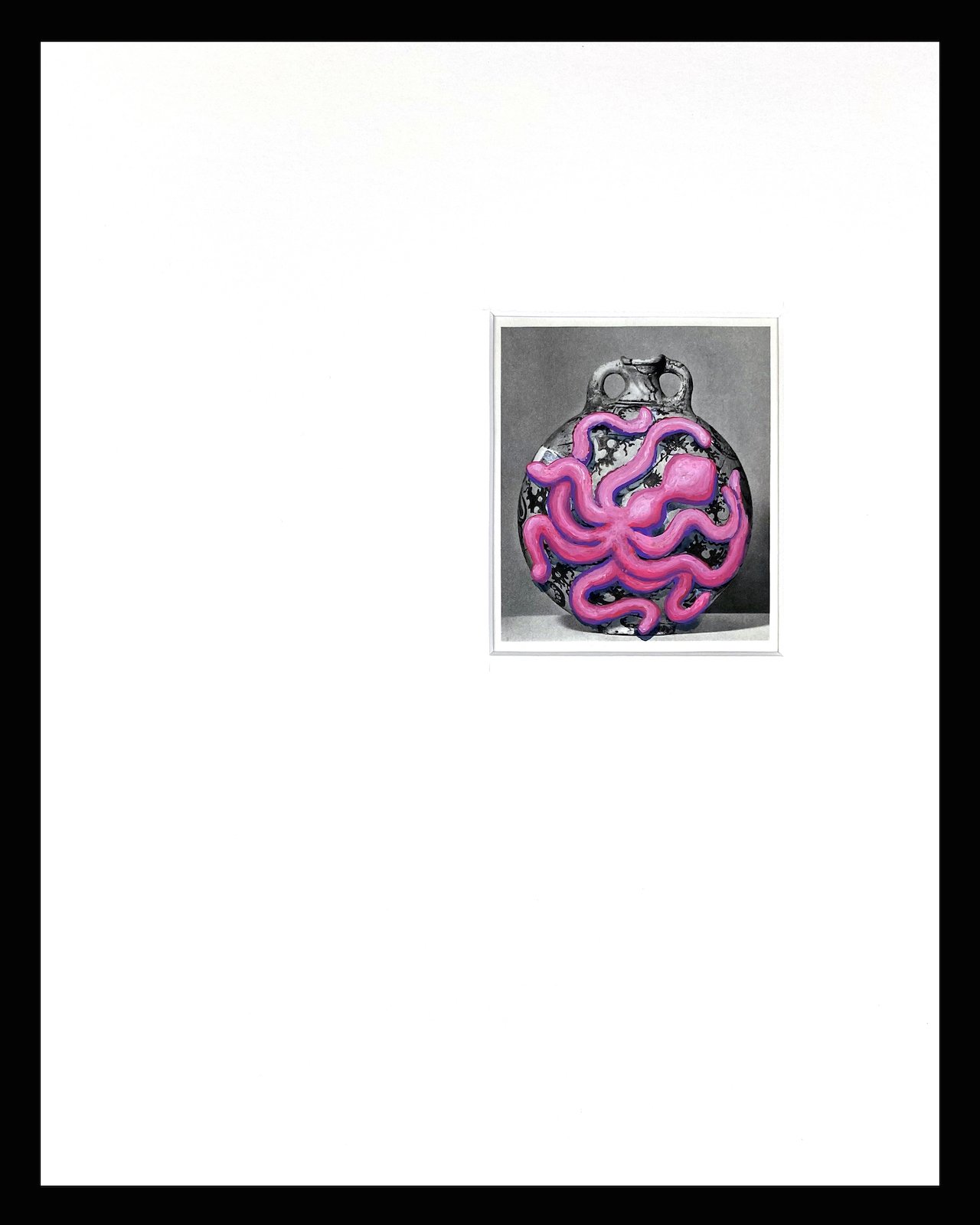
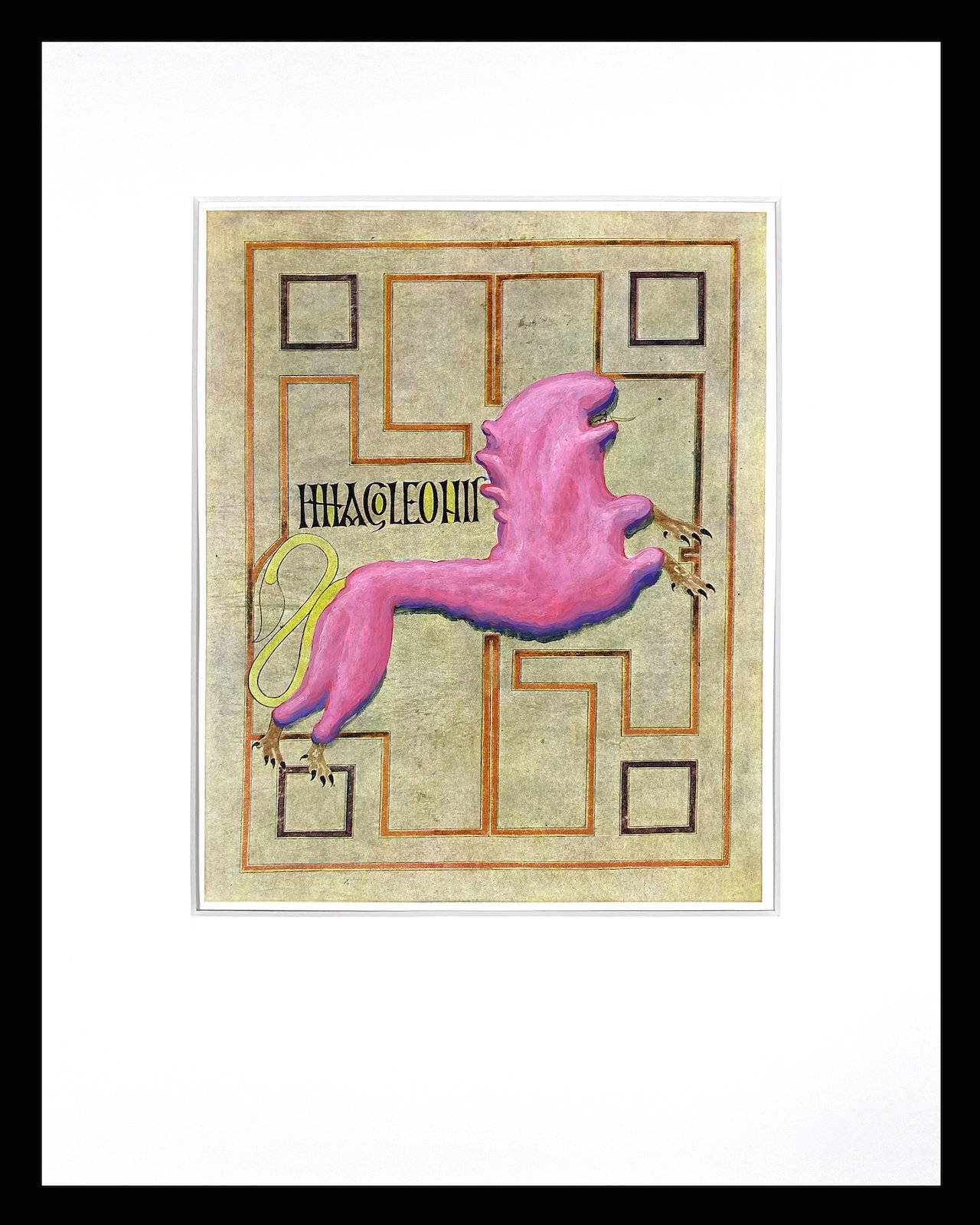
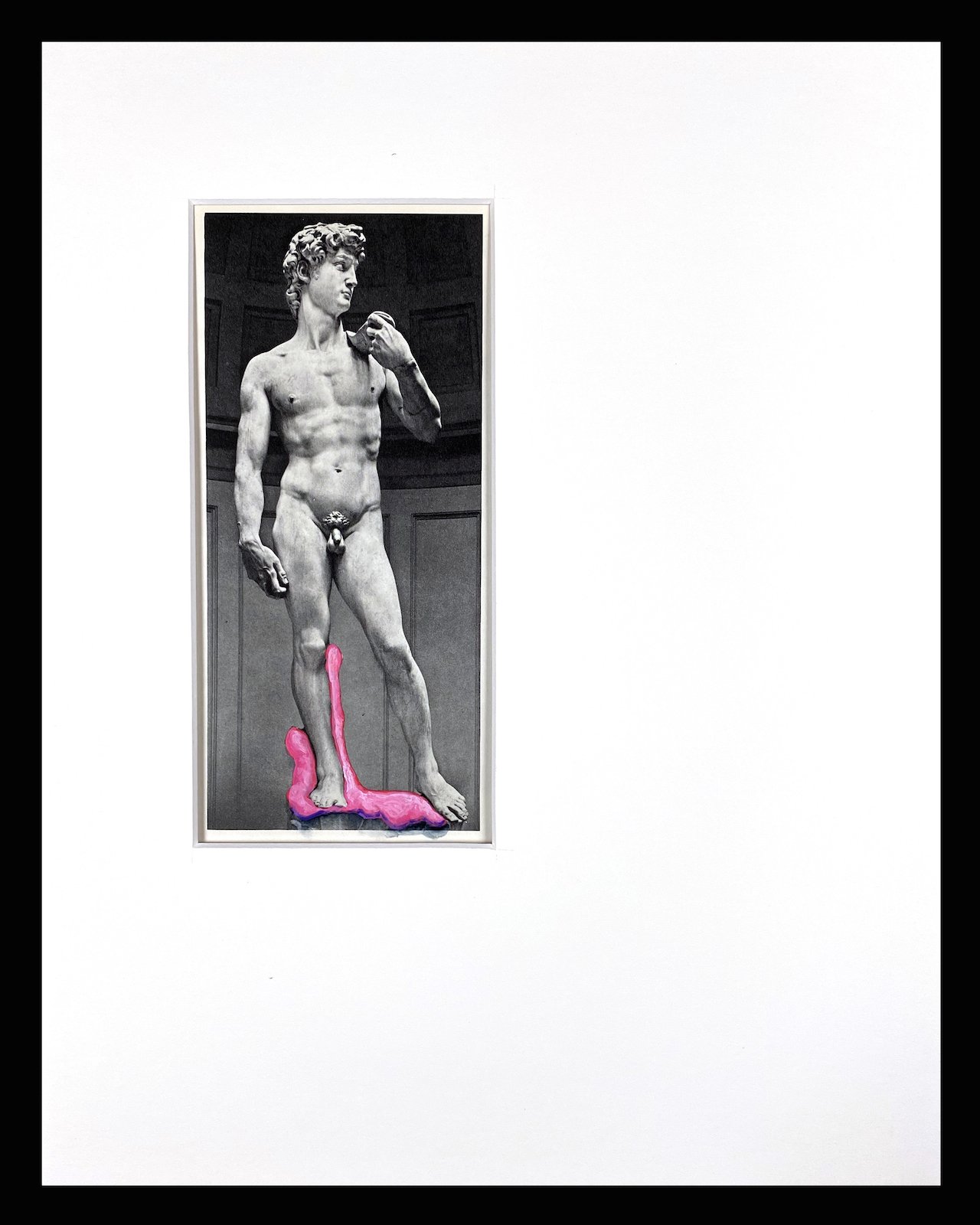
AAS: In Part 4: The Modern World - Chapter 5: Twentieth-Century Architecture, you reimagined some iconic architecture. What kinds of reaction from the public have you gotten from this project?
Bubble Gum on Frank Lloyd Wright “Robie House” (figure 846) – Part 4: Chapter 5. Twentieth-Century Architecture, acrylic, watercolor, ink on textbook paper, framed: 15” x 12”
Bubble Gum on Janson’s History of Art Part 4: The Modern World - Chapter 5: Twentieth-Century Architecture, 8 parts
TR: This is one chapter from the twenty-seven chapters as a part of BGOJHoA series. It is interesting that you choose the architecture chapter to show, as architecture was my original major in college before switching to art.
Artists that work with the fusion of the serial and the individual have always been influential to me. For the last two decades, I have been working on different series of mixed media paintings and drawings that contextualize the serious with humor. When the pandemic hit and in-person art events were cancelled, I stopped working on larger more complex individual pieces and went back to working on smaller more intimate pieces by painting bubble gum over images removed from art history textbooks (for fun and self-entertainment). Realizing the potential for making a more complex statement, I then planned this series. I now have an intimate relationship with this particular book and wish that others can understand that intimate relationship.
It has also been interesting to see how individuals respond to the work. Pieces that individuals viewing the exhibition responded to were ones that they had had a specific connection with. In other words, they gravitated to images of bubble gum painted over specific artwork that they had interacted within their own past history. This was a pleasant surprise to me.
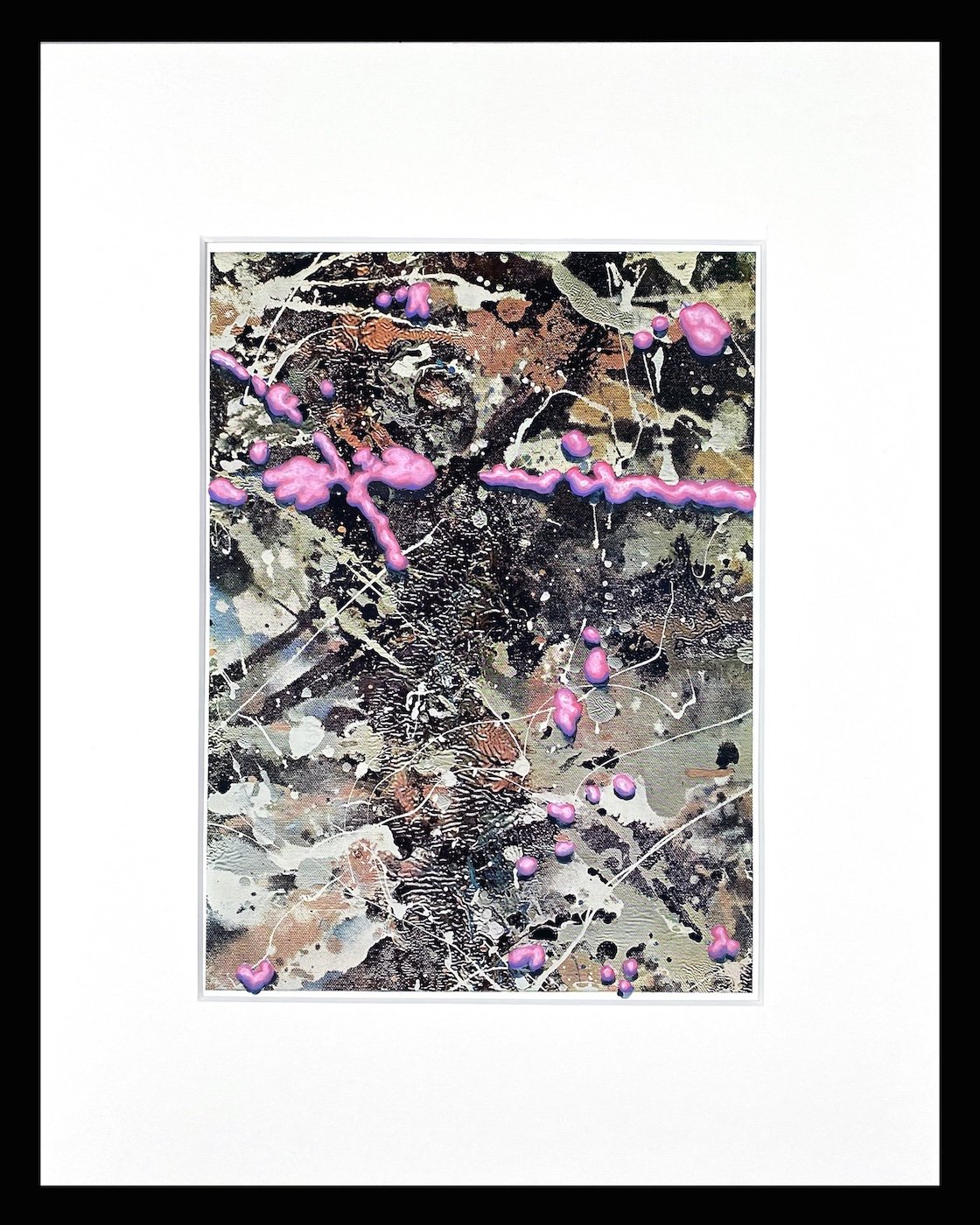
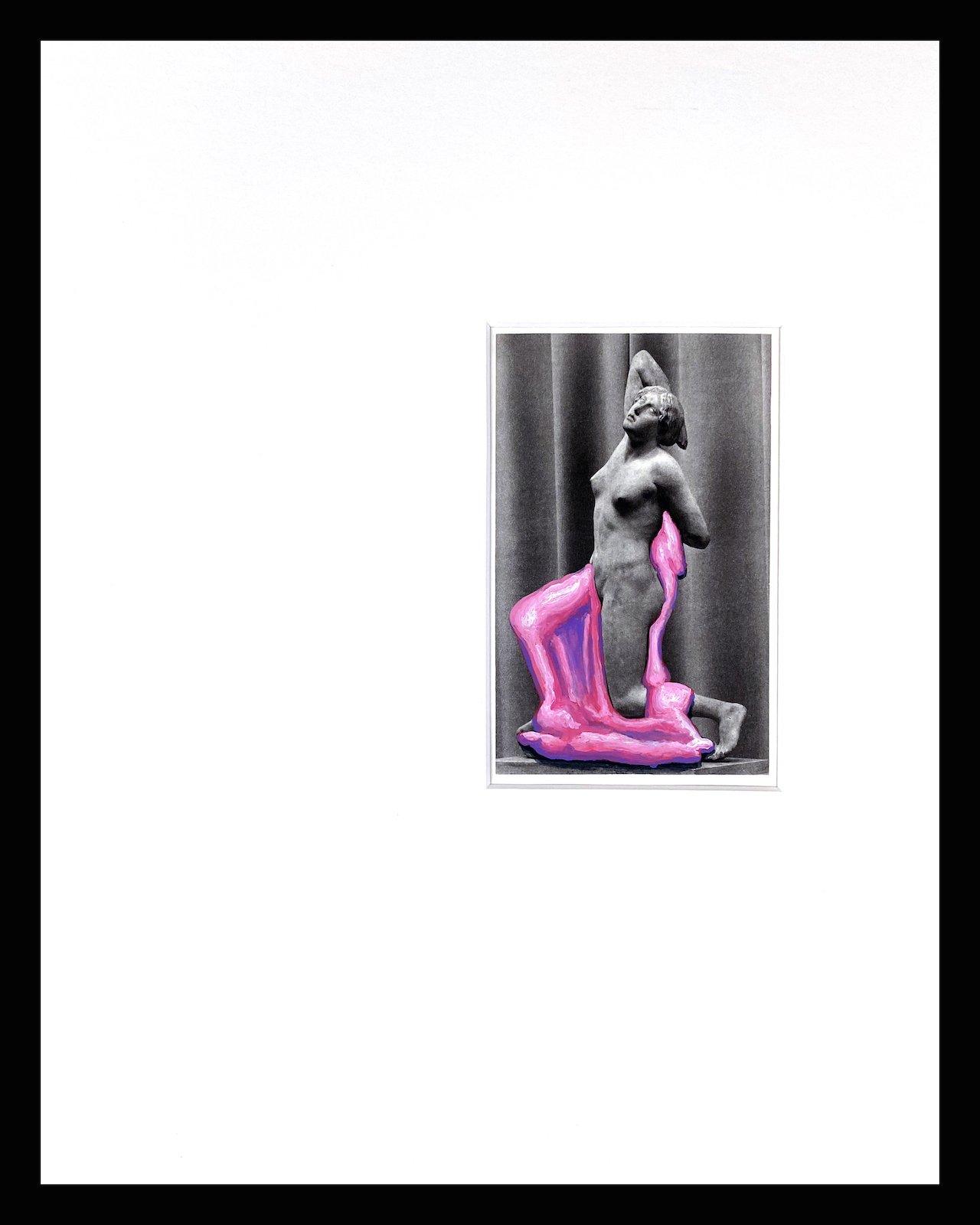
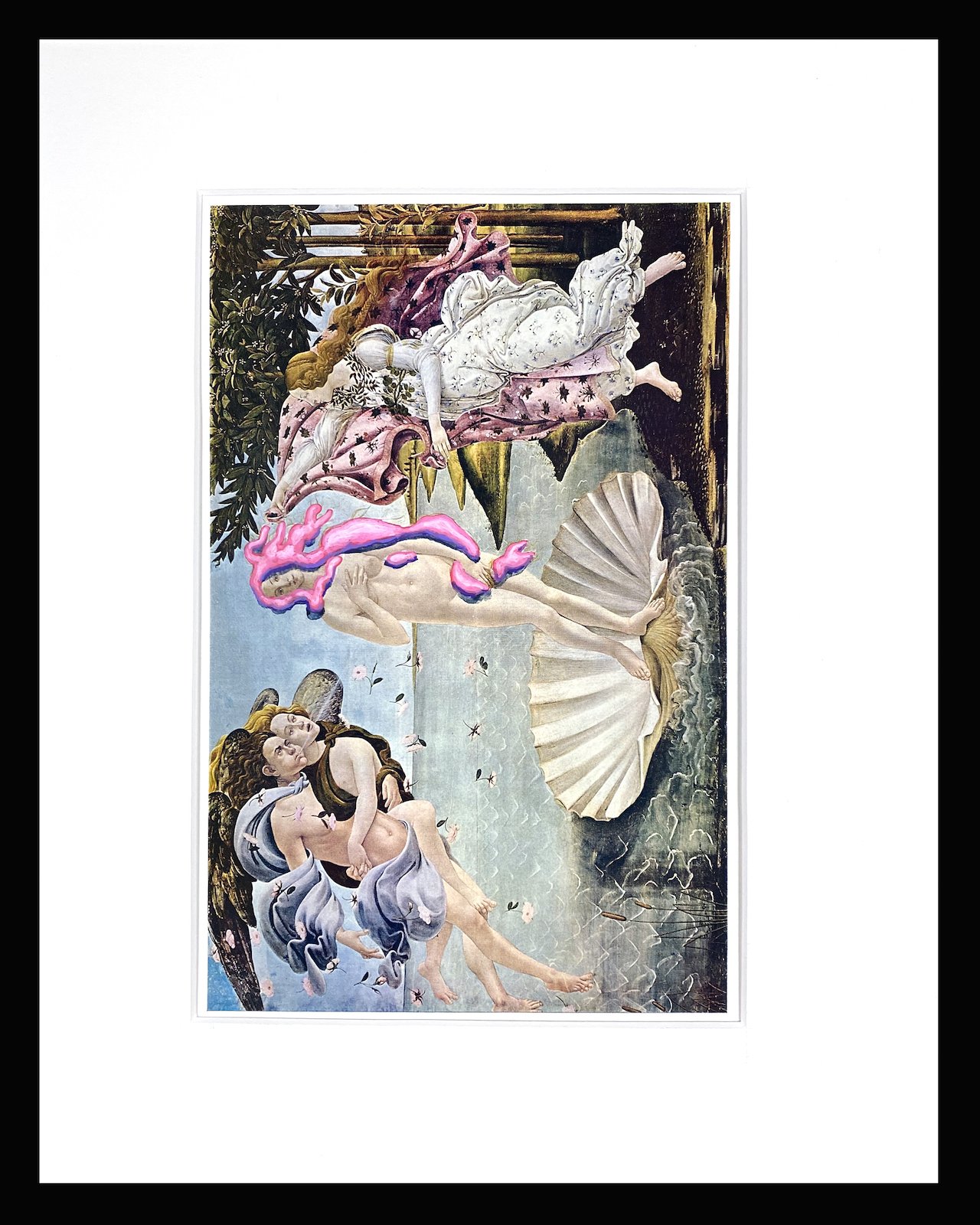
AAS: In Las Double Bubble, you use a lot of different imagery. Tell me about that piece.
Las Double Bubble, charcoal, acrylic, watercolor, color pencil, and graphite on paper, 40” x 30”
TR: From the Danger, Danger Series, Las Double Bubble is a mixed media (charcoal, color pencil, acrylic, and watercolor) on paper piece that incorporates imagery of a toy of mine (a Dr. Strange figure), wrapped bubble gum, bubble gum over people, blank thought balloons, an organizational line drawing, an optical illusion, and art historical references (a figure from the Abu Temple, and an abstract expressionistic splatter). The main or initial reference is the painting Las Meninas, by Spanish artist Diego Velazquez, a painting that exemplifies the mystery and enigmatic stance of Baroque Art. In the original work Velazquez (I assume) was “asked” to paint a portrait of the 5-year-old daughter of King Philip IV and Mariana of Austria. In this portrait of the princess, he includes portraits of her maids of honor (“las meninas”), portraits of her chaperones, teachers, and bodyguard, a portrait of the family dog, and a self-portrait. Also, in this portrait painting, Velazquez is working on a painting (a portrait). But in this painting, Velazquez is not painting this portrait. The painting that he is working on in this painting is a painting of the King and Queen (who are loosely painted as a reflection in a mirror above the princess’s head). Whew! So the more involved you get with the referenced painting the more unclear the subject matter gets. I have taken this original reference as a point of departure. And have added “my” references of “portrait.” There is DANGER in going down a rabbit hole.
“The idea of the frivolous amongst the sacred interests me. “
AAS: Tom, I have to ask, from what areas of your mind do you think the images you paint and construct come from? Are you a collector of pop culture imagery? Do you consider yourself a Pop Art artist?
TR: Phil, no, I do not consider myself a Pop Art artist. That is a historical term that relates to specific artists from a specific time. I incorporate imagery from my personal background and experiences. I have lived in a time where images are everywhere, and we filter out more than we absorb. If we tried to process it all, our heads would explode. But I do have stuff and I include that stuff in paintings and drawings to attempt to make sense of existence and the human condition. I do keep a lot of my “stuff” in my studio; I view it every day and try to include it into my art making practices. So, if you define a Pop Art artist as someone who blurs the line between Art and Life, then, yes, I am a Pop Art artist. Damn, I just contradicted myself.
AAS: In Danger: army guys, storm, bubble gum Stonehenge, organizational diagram #2 you combined another of your favorite subjects, toy soldiers with bubble gum. What inspired that piece?
Danger: army guys, storm, bubble gum Stonehenge, organizational diagram #2, charcoal, acrylic, color pencil on paper, 19” x 11”
TR: Storms. Clouds. Dusk. This was one of the first pieces of mine to use bubble gum imagery. An image of a megalith, the most infamous one being Stonehenge, is included. I did actually make a maquette made with bubble gum to study and paint. At this time, my work was exploring toys combined with art history references and organizational line drawings (or diagrams that address different thought processes or ways of thinking about things or thinking about organizing things). Born in 1966, I got to see images of the Vietnam War on a black and white TV and then play with green plastic army “guys.”
AAS: Your series Germs / Color Theory (or Albers has an Infection Interaction) was in the 2016 Delta Exhibition. In it you use another of your favorite topics, germs, to examine the color interaction theories of Josef Albers. Tell me about that installation.
Germs / Color Theory (or Albers has an Infection Interaction), graphite, watercolor, and acrylic on paper, 20 parts: each 14” x 11”
TR: Joseph Albers’ book Interaction of Color was very influential to me. I used to teach a color theory class and that was the textbook I used. And, of course, I’ve referenced Albers work in artwork.
Watching the nightly news is concerning. We are constantly bombarded with news that predicts, “the end is nigh.” For the last number of decades, “the end” is coming not as imminent threats of bombing or invasion, but as a biological “invasion.” When hearing about these biological threats, I’ve often made drawings or paintings – not intended to be shown – to explore a personal understanding of these issues. This series was the first to be made with the intention of fusing that idea of the dangerous with the attractive, or the wanted with the unwanted, or the perilous with the striking.
AAS: Like you, I grew up (a number of years before you) watching cartoons on Saturday morning and always loved the Pink Panther, and the Tasmanian Devil (Taz) was one of my favorites! Tell me about that wonderful piece, Chapter 31: “What is post-modernism?” Charles Jencks and Oprah “Change your bra, change your life?”
Chapter 31: "What is Post-Modernism?" Charles Jencks and Oprah "Change your bra, change your life”, mixed media on paper, 52" x 42"
TR: The Chapter Series, a series that I worked on for almost a decade in the early 2000’s, was featured in a solo exhibition, Tom Richard: Cereal Inquiries, in 2008 at the Arkansas Arts Center (now the Arkansas Museum of Fine Arts). I made paintings and drawings based on chapters from the book From Modernism to Postmodernism, An Anthology having a conversation with a contemporary pop culture source (usually a TV show, such as The Real Housewives of Orange County, Mad Money, or Dr. Phil).
I chose one of my “toys” as an initial image starting point and worked backwards (or from foreground to background to include stuff in or into the space). I, then, made connections between image and text or between text and image. These connections were absurd or rational, agreeable or offensive, ambiguous or explicit. It was not linear; image and text choice was not pre-planned but was reactionary.
This particular piece, Chapter 31: “What is post-modernism?” Charles Jencks and Oprah “Change your bra, change your life?” fuses text from these two sources. Jencks, in his essay, discusses that the demise of Modern Architecture is based upon its failure to communicate with inhabitants or users about a building’s function; Oprah had an infomercial for a new bra that would revolutionize women’s undergarments (I watched that show on my mother-in-laws couch in NOLA on a Christmas visit). Images included are: a Pink Panther Bendy figure, a “Sears” catalog undergarment advertisement on “tracing paper with painters tape”, a Tasmanian Devil plastic figure with lipstick and a hair bow superimposed, airplanes made out of pine twigs tied with pine straw, a high-rise being destroyed, targets, a venus fly trap plant and flies, chaos-theory patterns, a blue wooden locomotive toy, “rose” shaped soap bars (my grandmother had these in her guest bathroom and we could not touch them), a city skyline, and women (or boobs) images as ink contour line drawings pulled from art history.
While working on these pieces connections between things were not rationally planned but often happened as a very quick reaction. Taz, stomping on the building or destroying modernist architecture, references King Kong or the video game “Rampage.” The pink panther bendy was drawn early in the pieces process. The city skyline was added much later in the process to turn him into a skinny parade balloon. The soap roses (and targets) reference boobs and break up or make different spaces within the piece. Again, it’s intentionally ambiguous.
AAS: Tell me about the art program at UAM.
TR: A unique characteristic of concentrating in art at UAM is that every senior has the opportunity to have a solo exhibition unlike at other higher education institutions where seniors participate in group exhibitions where they only exhibit a few pieces. At UAM, a Senior Thesis course is taught to guide students through the process of making work, developing a body of work, finishing the work (matting, framing, and presentation), developing an artist statement, resume building, installing the work, announcement and poster development, and PR.
As gallery director, I have developed a visiting artist series where 2 to 4 visiting artists exhibit annually in the Glassblock Gallery and also give a talk or demonstration to UAM students. This gives UAM students the opportunity to interact with a dozen or more professional artists while they are students to gain an understanding of the diverse opportunities of careers available in the field of art.
AAS: You have an extensive exhibition record, both regionally and nationally. What do you have in the works?
TR: Next week, I will be crating a shipping a piece to the Fort Smith Regional Art Museum in Fort Smith, AR. This year’s the RAM Annual Invitational: Inclusive will be on exhibit May 25 - August 25, 2024. The work chosen for the exhibition is a six-piece installation from my You are a genius, if you can spot the one that is different series. They are acrylic and watercolor paintings on paper that feature images of wrestling figures nailed to targets.
I consistently search for recurring and new spaces to exhibit my work. I generally apply to 10 - 30 calls for art annually and have a success/acceptance rate of about 25%. One year it was as high as 80%. That was a crazy year. I really had to “learn” a system for keeping track of self-imposed matting and framing deadlines and externally imposed crating and shipping deadlines, while also making new work and doing a bit of teaching. I have learned through the years to thrive off the acceptances and not to dwell upon the rejections. I currently have four submissions to exhibitions pending and have a few solo exhibitions planned for 2025.
As an artist I have had to wear many hats, not only being an art maker, but also being a carpenter, framer, documenter, editor, bookkeeper, web designer, promoter, and marketer. I have just finished photo editing all my images from 2023 and I’m in the process of updating my webpage. Do what you love, and love what you do. Cheers!


